CBSE Class 10 Science Notes Chapter 4 Carbon and its Compounds Pdf free download is part of Class 10 Science Notes for Quick Revision. Here we have given NCERT Class 10 Science Notes Chapter 4 Carbon and its Compounds.
According to new CBSE Exam Pattern, MCQ Questions for Class 10 Science pdf Carries 20 Marks.
Carbon and its Compounds Notes CBSE Class 10 Science Chapter 4
Bonding in Carbon: The Covalent bond, Electron dot structure, Physical properties of organic compounds, Allotropes of Carbon.
Covalent Bond: The atomic number of carbon is 6. Its electronic configuration is 2, 4. It requires, 4 electrons to achieve the inert gas electronic configuration. But carbon cannot form an ionic bond
It could gain four electrons forming C 4- cation. But it would be difficult for the nucleus with six protons to hold on to ten electrons.
It could lose four electrons forming C 4+ cations. But it requires a large amount of energy to remove four electrons.
Thus, carbon overcomes this problem by sharing of its valence electrons with other carbon atoms or with atoms of other elements.
The bond formed by mutual sharing of electron pairs between two atoms in a molecule is known as Covalent Bond.
Types of Covalent Bond:
- Single Covalent Bond: When a single pair of electrons are shared between two atoms in a molecule. For example; F 2 , Cl 2 , H 2 etc.
- Double Covalent Bond: When two pairs of electrons are shared between two atoms in a molecule. For example; O 2 , CO 2 etc.
- Triple Covalent Bond: When three pairs of electrons are shared between two atoms in a molecule. For example; N 2 etc.
Electron Dot Structure: The electron dot structures provides a picture of bonding in molecules in terms of the shared pairs of electrons and octet rule.
Formation of Hydrogen Molecule
Atomic number of Hydrogen = 1
Number of valence electrons = 1

Formation of CH
4
Molecule
Atomic number of Carbon = 6 [2, 4]
Number of valence electrons = 4
Atomic number of Hydrogen = 1
Number of valence electrons = 1
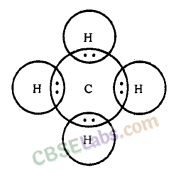
Formation of CO
2
Molecule
Atomic number of Carbon = 6 [2, 4]
Number of valence electrons = 4
Atomic number of Oxygen = 8 [2, 6]
Number of valence electrons = 6
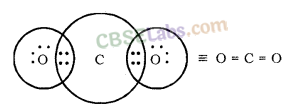
Formation of H
2
S Molecule
Atomic number of Sulphur = 16 [2, 8, 6]
Number of valence electrons = 6

Physical Properties of Organic Compounds
Most of the organic compounds have low boiling and melting point, due to the weak force of attraction (i.e., the inter-molecular force of attraction) between these molecules.
Most carbon compounds are poor conductors of electricity, due to the absence of free electrons and free ions.
| Compounds | M.P. (K) | B.P. (K) |
| Acetic acid (CH 3 COOH) | 290 | 391 |
| Chloroform (CHCl 3 ) | 209 | 334 |
| Ethanol (CH 3 CH 2 OH) | 156 | 351 |
| Methane (CH 4 ) | 90 | 111 |
Allotropes of Carbon
Allotropy:
The phenomenon in which the element exists in two or more different physical states with similar chemical properties are called Allotropy.
Carbon has Three Main Allotropes
- Diamond: In this, carbon, an atom is bonded to four other atoms of carbon forming three-dimensional structures. It is the hardest substance and an insulator. It is used for drilling rocks and cutting. It is also used for making jewellery.
- Graphite: In this, each carbon atom is bonded to three other carbon atoms. It is a good conductor of electricity and used as a lubricant.
- Buckminster Fullerene: It is an allotrope of the carbon-containing cluster of 60 carbon atoms joined together to form spherical molecules. It is dark solid at room temperature.
Versatile nature of Carbon, Hydrocarbons, Isomerism, Homologous series, Functional groups, Nomenclature of functional groups.
Versatile Nature of Carbon: The existence of such a large number of organic compounds is due to the following nature of carbon,
- Catenation
- Tetravalent nature.
(i) Catenation:
The self linking property of an element mainly carbon atom through covalent bonds to form long straight, branched and rings of different sizes are called Catenation.
This property is due to
- The small size of the carbon atom.
- The great strength of the carbon-carbon bond.
Carbon can also form stable multiple bonds (double or triple) with itself and with the atoms of other elements.
Straight Chain

Branched Chain
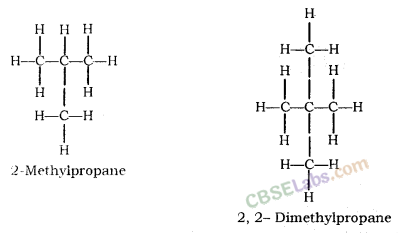
Rings
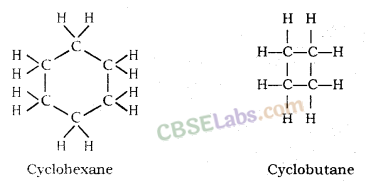
(ii) Tetravalent Nature:
Carbon has valency of four. It is capable of bonding with four other atoms of carbon or some other heteroatoms with single covalent bond as well as double or triple bond.

Hydrocarbons: Compounds of carbon and hydrogen are known as hydrocarbons.
For example; Methane (CH
4
), Ethane (C
2
H
6
), Ethene (C
2
H
4
), Ethyne (C
2
H
2
) etc.
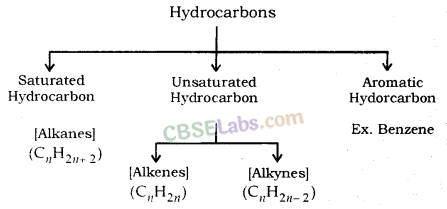
Saturated Hydrocarbon (Alkanes):
General formula is C
n
H
2n+2
.
n = number of carbon atoms.
In this, the carbon atoms are connected by only a single bond.
For example; Methane (CH
4
), Ethane (C
2
H
6
) etc.

Unsaturated Hydrocarbons
Alkenes:
General formula is C
n
H
2n
, where n = number of carbon atoms.
In this, the two carbon atoms are connected by double bond.

Alkynes:
General formula is C
n
H
2n-2
, where n = number of carbon atoms. In this, the two carbon atoms are connected by triple bond.

Electron Dot Structure of Hydrocarbons
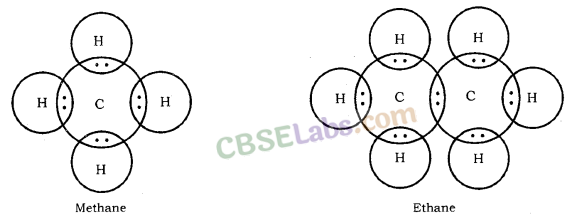
Isomerism: Compounds having the same molecular formula but different structural formula and properties are known as Isomers and this phenomenon is known as Isomerism.
Structural Isomerism:
Compounds having the same molecular formula but different structures are called Structural isomers. Example: Isomers of butane (C
4
H
10
)

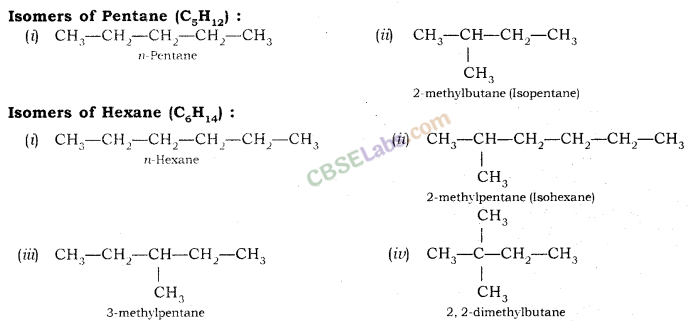
Homologous Series: Series of organic compounds having the same functional group and chemical properties and successive members differ by a CH 2 unit or 14 mass units are known as Homologous series.
Homologous series of Alkanes, Alkenes and Alkynes
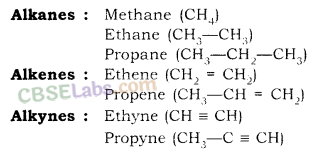
Characteristic of Homologous Series
- The successive members in homologous series differ by CH 2 unit or 14 mass unit.
- Members of given homologous series have the same functional group.
- All the members of homologous series shows similar chemical properties.
Functional Group:
An atom or group of atoms present in a molecule which largely determines its chemical properties are called Functional Group.
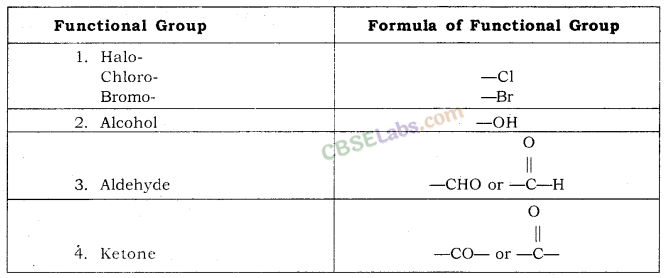

Nomenclature of Organic Compounds:
It is difficult to remember millions of compounds by their individual common name. Thus, to systematize the nomenclature of organic compounds IUPAC (International Union of Pure and Applied Chemistry) has given certain rule which is as follows:
1. Identify the Number of Carbon Atoms in the Compound
| S. No | Number of Carbon Atoms | Word Root (-) (Suffix) | Single bond |
| 1. | One carbon atoms (1-C) | Meth | + ane |
| 2. | Two carbon atoms (2-C) | Eth | + ane |
| 3. | Three carbon atoms (3-C) | Prop | + ane |
| 4. | Four carbon atoms (4-C) | But | + ane |
| 5. | Five carbon atoms (5-C) | Pent | + ane |
| 6. | Six carbon atoms (6-C) | Hex | + ane |
2. Identify the functional group
| S. No. | Functional Group | Prefix | Suffix |
| 1. | Double bond (=) | — | ene |
| 2. | Triple bond (≡) | — | yne |
| 3. | Chlorine (—Cl) | Chloro | — |
| 4. | Bromine (—Br) | Bromo | — |
| 5. | Alcohol (-OH) | — | ol |
| 6. | Aldehyde (-CHO) | — | al |
| 7. | Ketone (-CO-) | — | one |
| 8. | Carboxylic acid (-COOH) | — | oic acid |
3. Name the Compounds By Following Order
Prefix + Word Root + Suffix
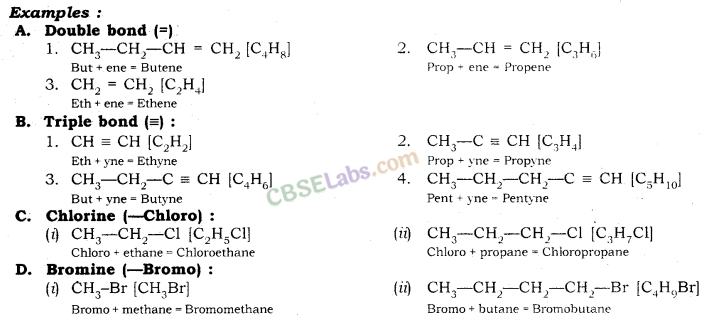
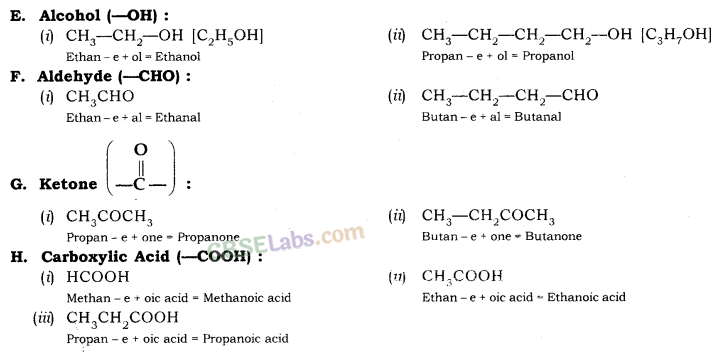
Chemical Properties of Carbon Compounds:
The important chemical properties are as follows:
1. Combustion:
The complete combustion of carbon compounds in the air gives carbon dioxide water, heat and light.
CH
3
CH
2
OH(l) + O
2
(g) → CO
2
(g) + H
2
O(l) + Heat and light
Carbon burns in air or oxygen to give carbon dioxide and heat and light.
C(s) + O
2
(g) → CO
2
(g) + Heat and light
Saturated hydrocarbons burn with a blue flame in the presence of a sufficient supply of air or oxygen.
CH
4
(g) + 2O
2
(g) → CO
2
(g) + 2H
2
O(l) + Heat and light
In presence of limited supply of air, saturated hydrocarbon forms a sooty flame.
Unsaturated hydrocarbons burn with a yellow smoky flame.
The gas and kerosene stove used at home has inlet for air so that, burnt to given clean blue flame.
Due to presence of small amount of nitrogen and sulphur, coal and petroleum produces carbon dioxide with oxides of nitrogen and sulphur which are major pollutant.
2. Oxidation:
Oxidation of ethanol in presence of oxidizing agents gives ethanoic acid.

Oxidizing Agent:
Some substances are capable of adding oxygen to others, are known as Oxidising Agent.
Example: Alkaline KMnO
4
(or KMnO
4
—KOH)
Acidified K
2
Cr
2
O
7
(or K
2
Cr
2
O
7
—H
2
SO
4
)
KMnO
4
– Potassium permanganate
K
2
Cr
2
O
7
– Potassium dichromate
3. Addition Reaction:
Addition of dihydrogen with unsaturated hydrocarbon in the presence of catalysts such as nickel or platinum or palladium are known as Hydrogenation (addition) reaction.
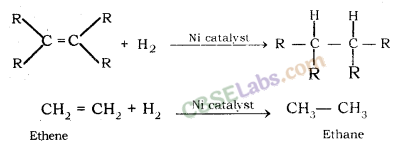
Catalyst: Substances that cause a reaction to occur or proceeds to different rate without consuming in it are called a catalyst. For example; Ni, Pt, Pd, etc.
Process of converting vegetable oil into solid fat (vegetable ghee) is called Hydrogenation of Oil.
Vegetable oil + H
2
\(\xrightarrow [ Ni\quad Catalyst ]{ \triangle }\) Vegetable ghee
Vegetable fats are saturated fats which are harmful for health.
Vegetable oil containing unsaturated fatty acids are good for health.
4. Substitution Reaction:
Replacement of one or more hydrogen atom of an organic molecule by another atom or group of the atom is known as Substitution Reaction.

Some Important Carbon Compounds :
Ethanol (CH
3
CH
2
—OH): Commonly known as Ethyl Alcohol.
Physical Properties
- It is colourless, inflammable liquid.
- It is miscible with water in all proportions.
- It has no effect on the litmus paper.
Chemical Properties
-
Reaction with sodium

-
Reaction with concentrated H2SO4 (Dehydration Reaction)

Dehydrating agent:
Substances which removes water from ethanol (alcohols) is known as Dehydrating agent. For example; Cone. H
2
SO
4
.
Uses: As solvent, as antiseptic (tincture iodine), as anti-freeze in automobiles.
Ethanoic Acid (CH 3 COOH): Commonly known as Acetic acid. 5-8% of ethanoic acid in water is called Vinegar. The melting point of pure ethanoic acid is 290 K and hence, it often freezes in cold climate so named as glacial acetic acid.
Physical Properties
- It is a colourless, pungent-smelling liquid.
- Miscible with water in all proportions.
- Turns blue litmus to red.
Chemical Properties
(i) Esterification Reaction:
Reaction of ethanoic acid with an alcohol in the presence of a few drops of conc. H
2
SO
4
as catalyst gives a sweet-smelling substance known as Esters, called Esterification reaction.

Esters are used in making perfumes and flavouring agents.
Saponification Reaction:
Reaction of esters with sodium hydroxide, gives alcohol and sodium salt of carboxylic acid (soap). This reaction is known as Saponification Reaction.

(ii) Reaction with Carbonates and Hydrogen Carbonates:
Ethanoic acid reacts with sodium carbonates and sodium hydrogen carbonates to give rise to a salt, carbon dioxide and water.

- Used as vinegar.
- Used as raw material for the preparation of acetyl chloride and esters.
Soap:
Sodium or potassium salts of long chain fatty acids is called Soap.
General formula: RCOO
–
Na
+
Detergent:
Ammonium and sulphonate salts of long chain fatty acids are called Detergent.
Example: CH
3
—(CH
2
)
11
—C
6
H
4
—SO
3
Na.
Hard and Soft Water:
Water that does not produce lather with soap readily is called Hard water and which produces lather with soap is called Soft Water.
Hardness of water is due to the presence of bicarbonates, chlorides and sulphate salt of calcium and magnesium.
Difference between soaps and detergents
| Soaps | Detergents |
| (i) These are sodium or potassium salts of long chain fatty acids. | (i) These are ammonium and sulphonate salts of long chain fatty acids. |
| (ii) Ionic part of the soap is —COO – Na + | (ii) Ionic part of detergent is —OSO 3- Na + . |
| (iii) Their efficiency decreases in hard water | (iii) Their efficiency is unaffected in hard water. |
| (iv) Soaps are biodegradable. | (iv) Detergents are non-biodegradable. |
Advantage of Detergents:
The main advantage of detergent over soaps is that soaps cannot be used in hard water for washing because hard water reacts with soap to form curdy white precipitate called Scum.

Thus, in hard water, soap does not give lather while detergent does.
Cleansing Action of Soaps and Detergents:
Both soaps and detergents cantains two parts. A long hydrocarbon part which is hydrophobic (water repelling) in nature and a short ionic part which is hydrophillic (water attracting) in nature.
The hydrocarbon part of the soap molecule links itself to the oily (dirt) drop and ionic end orients itself towards water and forms a spherical structure called micelles. The soap micelles helps in dissolving the dirt in water and wash our clothes.
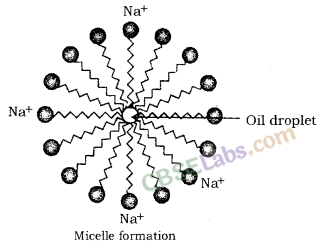
Covalent Bond:
A chemical bond formed between two atoms by sharing of valence electrons between two atoms so that each atom acquires the stable electronic configuration of the nearest noble gas.
Covalency: The number of electrons contributed by each atom for sharing.
Carbon always forms a covalent bond:
Atomic no of carbon is 6. So, its configuration is K-2, L-4. Therefore, it should either lose or gain 4 electrons to achieve the noble gas configuration and become stable.
However, it is difficult for carbon to gain or lose four electrons because of the following reasons:
- It cannot gain 4 electrons to form C 4- ion having Neon gas (2, 8) configuration because this anion would be highly unstable due to a large amount of energy required to overcome the forces of repulsion between the four electrons being added and the six electrons already present in the carbon atom.
- It cannot lose 4 electrons to form C 4+ ion having Helium gas (2) configuration because this cation would be highly unstable due to a large amount of energy required to remove four electrons from the carbon atom.
Tetravalency of Carbon: A carbon atom has four electrons in the valence shell. Therefore, carbon forms four covalent bonds, i.e., carbon is tetravalent.
Allotropic forms of Carbon:
The phenomenon of existence of an element in two or more forms which have different physical properties but identical chemical properties is called allotropy.
Three allotropic forms of carbon:
- Diamond
- Graphite
- Fullerenes
Hydrocarbon: Organic compounds of carbon and hydrogen are called hydrocarbons.
Saturated Compound: Compounds of carbon which have only single bonds between the carbon atoms are called saturated compounds e.g., Ethane, Propane, Butane etc.
Unsaturated Compound:
Compounds of carbon which contain one or more double or triple bonds between carbon atoms are called unsaturated compounds
e.g., Ethene, Propene, Butyne, etc.
Alkanes
- General formula – C n H 2n+2
- Saturated hydrocarbons
- Methane – CH 4
- Ethane – C 2 H 6
Alkenes
- General formula – C n H 2n
- Unsaturated hydrocarbon.
- Ethene – C 2 H 4
- Propene – C 3 H 6
Homologous series: A family of organic compounds having the same functional group, similar chemical properties and the successive (adjacent) members differ by a CH 2 unit or 14 mass unit.
Characteristics of a homologous series:
All the members of a homologous series can be represented by a general formula.
- Alkane – C n H 2n+2
- Alkyne – C n H 2n-2
- Alcohol – C n H 2n+1 OH
- Ketone – C n H 2n+1 COC n H 2n+1
- Alkene – C n H 2n
- Haloalkane – C n H 2n+1 X
- Aldehyde – C n H 2n+1 CHO
- Carboxylic acid – C n H 2n+1 COOH
The molecular formula of two successive (adjacent) members of a homologous series differs by a CH
2
unit.
The molecular masses of any two successive members of a homologous series differ by 14 u.
All the members of a given homologous series have the same functional group.
All the members of a series show similar chemical properties.
The members of a homologous series show a gradation in physical properties.
Nomenclature of carbon compound:
International Union of Pure and Applied Chemistry (IUPAC) decided some rules to name the carbon compounds. This was done to maintain uniformity throughout the world. Names which are given on this basis are popularly known as IUPAC name. The rules for nomenclature are as follows:
(i) Identify the number of carbon atoms in the carbon compound. Name the carbon compounds according to the number of carbon atoms.
Example, Saturated hydrocarbon having one carbon atom is named as Methane. Saturated hydrocarbon having two carbon atoms is named as Ethane.
- An unsaturated hydrocarbon with a double bond having two carbon atoms is named as Ethene.
- An unsaturated hydrocarbon with a triple bond between carbon atoms is named as Ethyne.
(ii) If the structure has a branched chain, identify the longest chain and then identify the number of carbon atoms.
(iii) In the case of a functional group present, write the prefix or suffix of the functional group as given below. Then write the name of the parent compound:
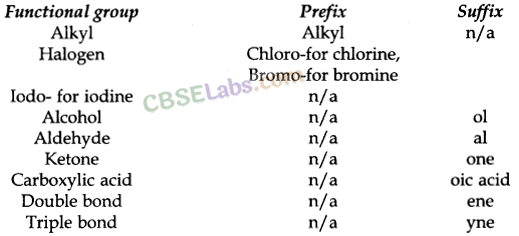
Chemical properties of Ethanol
- Ethanol (C 2 H 5 OH) compound is a colourless liquid at room temperature. It is the second member of the homologous series of alcohols. Its common name is ethyl alcohol. Its functional group is – OH.
- It has a very low melting point (156 K) and low boiling point (351 K or 78°C).
- Ethanol is highly soluble in water.
- Ethanol is one of the main components of alcoholic drinks.
- It is a good organic solvent.
- It is a neutral substance, so it does not have any effect on either blue litmus solution or red litmus solution.
-
It bums with a blue flame in the presence of O
2
of air. This combustion is an oxidation process.

-
In the presence of alkaline KMnO
4
, it is oxidised to ethanoic acid.

-
Ethanol alcohol reacts with sodium(Na) metal vigorously to form sodium ethoxide and evolves H
2
gas.
2C 2 H 5 OH + 2Na → 2C 2 H 5 ONa (Sodium ethoxide) + H 2 (g) -
Ethanol on dehydration in the presence of cone. H
2
SO
4
acid at 443 K forms ethene gas. H
2
SO
4
acid absorbs water molecules from the alcohol molecules and acts as a strong dehydrating agent.

Chemical properties of Ethanoic acid
- Ethanoic acid commonly called acetic acid (CH 3 COOH) is a colourless liquid. The functional group present in it is carboxylic acid – COOH.
- It’s melting point is 290 K and the boiling point is 391 K.
- Being an acid, it turns blue litmus red.
- It is sour in taste.
-
Ethanoic acid reacts with alcohols in the presence of cone. H
2
SO
4
acid to form sweet smelling compounds called esters.

-
Ethanoic acid reacts with bases to form its salt and water.

-
It reacts with carbonate and hydrogen-carbonate compounds of metals to form its salt (sodium ethanoate commonly called sodium acetate) and release CO
2
gas.

Cleansing action of soap:
The dirt is generally held to the surface of a dirty cloth by a thin film of oil or grease.
When a dirty cloth is treated with soap or detergent solution, the non- polar tail of the soap or the detergent dissolve in oil or grease while the polar heads are held by the surrounding water. Soap or detergent micelle is formed with the oily or greasy dirt lying at their Centre (Soap or detergent is attracted both by the greasy dirt and water.
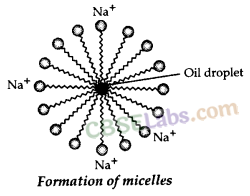
When the surface of the cloth is mechanically scrubbed or beaten on a stone or with a wooden paddle or agitated in a washing machine, the loosened oily particle is removed from the dirty surface and the cloth is cleaned. Detergents lower the surface tension of water to a greater extent than soap, therefore the cleansing action of detergent is much higher than those of soaps.
1. The earth’s crust has only 0.02% carbon in the form of minerals (like carbonates^bicarbonates, coal, and petroleum).
2. The atmosphere has 0.03% of carbon dioxide.
3. In spite of its small amount available in nature, carbon is a versatile element as it forms the basis for all living organisms and many things which we use.
4. Bonding in carbon :
- The atomic number of carbon = 6
- An electronic configuration has 2 electrons in K shell and 4 electrons in L shell.
- In order to attain the noble gas configuration, carbon should either gain 4 electrons or lose 4 electrons or can share it’s 4 electrons with some other element.
- The gain of 4 electrons (to form an octet, i.e., 8 electrons in C 4- anion) is difficult because then a nucleus with 6 protons will have to hold extra four electrons.
- Loss of 4 electrons (to attain duplet, i.e., 2 electrons like He atom in C 4+ cation) is difficult as it requires a large amount of energy to remove four electrons.
- Carbon, hence, overcomes this difficulty by sharing it’s four valence electrons with other atoms of carbon or with atoms of other elements. These electrons contributed by the atoms for mutual sharing in order to acquire the stable noble gas configuration is called covalency of that atom. Hence, carbon shows TETRACOVALENCY.
-
The simplest molecule formed by sharing of electrons (i.e., covalent bonds), can be represented by electron dot structure.
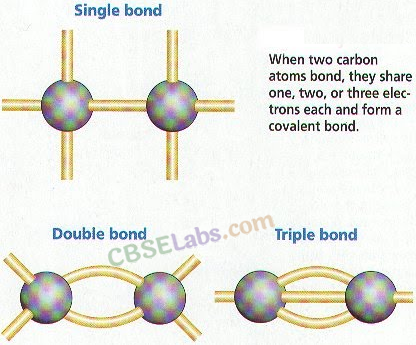
5. Allotropes of carbon:
The phenomenon by means of which an element can exist in two or more forms, with similar chemical properties but different physical properties are called allotropy and the different forms are called allotropes. Carbon shows three allotropic forms :
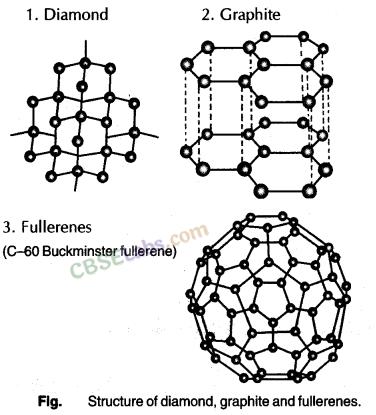
Note:
- Diamond is the hardest substance whereas graphite is very soft.
- Diamond is used for grinding and polishing of ‘ hard materials and graphite is used as a lubricant.
- Diamond has a three-dimensional rigid structure but graphite has a hexagonal sheet layer structure.
- Diamond is a bad conductor of electricity but graphite is a very good conductor of electricity.
6. Fullerenes: A new category of carbon allotrope, fullerenes are spherical in shape or a soccer ball like. The first fullerene identified was C-60 with 60 carbon atoms arranged like the geodesic dome designed by US architect, Buckminster Fuller, hence these are also known as Buckminster Fullerenes or Bucky Ball structures.
7. Cause of versatile nature of carbon:
Four main reasons for the versatile nature of carbon are:
(a) Catenation:
It is the unique property of self-linkage of carbon atoms by means of covalent bonds to form straight chains, or branched chains, or the rings of different sizes (as shown below):
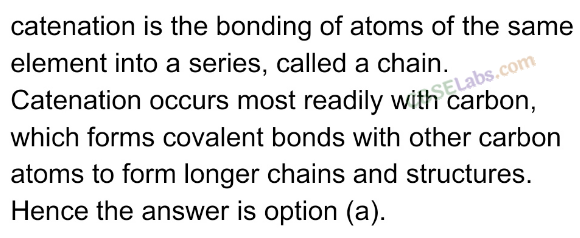
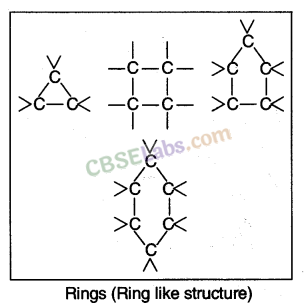
(b) Tetracovalency:
Due to small size, and presence of four valence electrons, carbon can form strong bonds with other carbon atoms, hydrogen, oxygen, nitrogen, or sulphur, etc. For example, compounds of carbon with hydrogen are called hydrocarbons.
(c) Multiple Bond Formation :
Small size of carbon also enables it to form multiple bonds, (i.e., double bonds or triple bonds) with other elements as well as with its own atoms. This increases the number of carbon compounds.
Note:
- Compounds of carbon with double bonds and triple bonds are called as unsaturated compounds while those with carbon-carbon single bonds are called saturated compounds.
- Alkenes (with —C = C —) and Alkynes (with —C = C—) are hence unsaturated, whereas Alkanes (with — C — C—) are saturated compounds.
(d) Isomerism:
The phenomenon by means of which the carbon compounds with same molecular formula show different structures, and properties, e.g., A chain of 4 carbon atoms can be written in two ways :

Hence, the number of carbon compounds increases to a huge number.
8. Hydrocarbons:
a Large number of hydrocarbons can be classified as:
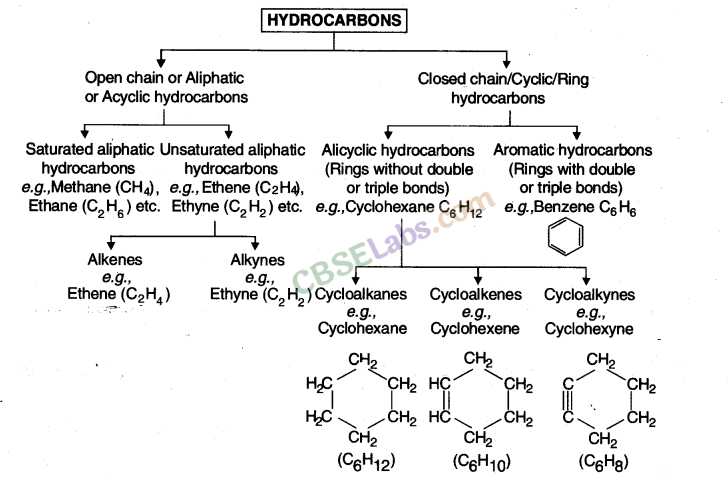
Note:
In an open chain, the name of parent chain is derived from the root word and suffix ane, ene or yne is added depending on the type of bond present in a chain :
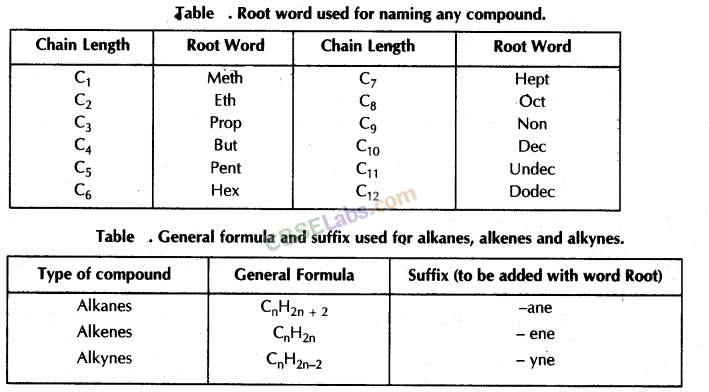
Important:
No alkene or alkyne is possible with single carbon atom because double or triple bond is not possible between carbon and hydrogen atom. It is only between two carbon atoms.
9. Functional Group:
- An atom or a group of atoms which when present in a compound gives specific properties to it, is called a functional group.
- A single line shown along with a functional group is called as its free valency by which it gets attached to a compound by replacing one hydrogen atom or atoms, e.g., -Cl.
- Functional group, replacing the hydrogen is also called as heteroatom because it is different from carbon, and can be nitrogen, sulphur, or halogen, etc.
Important:
Replacement of hydrogen atom by a functional group is always in such a manner that valency of carbon remains satisfied.
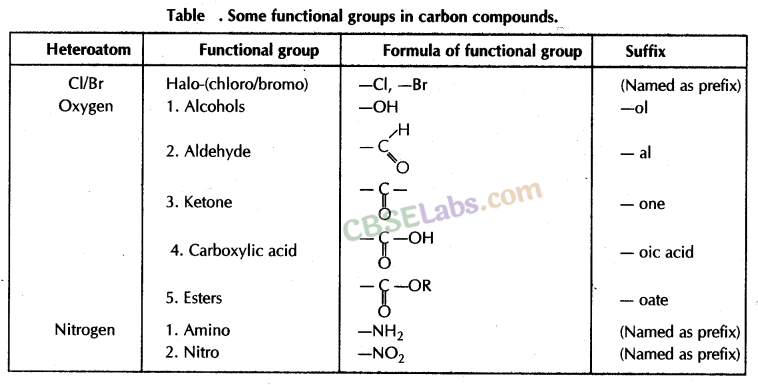
Note :
Cl is named as prefix Chloro; Br as Bromo; NH
2
as Amino and N0
2
as Nitro.
Important Note: Symbol ‘R’ in a formula represents an Alkyl Group which is formed by the removal of one hydrogen atom from an alkane.

10. Homologous series:
A series of organic compounds in which every succeeding member differs from the previous one by -CH
2
group or 14 a.m.u.
Note :
As the molecular mass increases in a series, : so physical properties of the compounds
show a variation, but chemical properties which are determined solely by a functional group, remains same within a series.
11. Nomenclature of Organic Compounds
-
Trivial or common names:
These names were given after the source from which the organic compounds were first isolated, e.g., If a compound has one carbon atom, then its common name will have root word form and so on (see table).
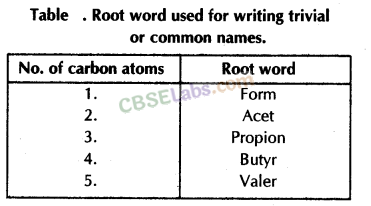
-
IUPAC name:
International Union of Pure and Applied Chemistry gave following rules for naming various compounds :
- Identify the number of carbon atoms and write the word root corresponding to it. e.g., If a number of carbon atoms is three, then the word root is a prop.
- Presence of a functional group is indicated by prefix or suffix as given in table 2, and table 3.
-
If the name of the functional group is to be given as a suffix, the last letter ‘e’ in the name of the compound is deleted and the suffix is added. e.g., a ketone with three carbon atoms is named as :
Propane – e = Propan + ‘one’ = Propanone. Alcohol with three carbons is propanol. Carboxylic acid with three carbons is propanoic acid. - Halogens, in IUPAC, are written as Prefixes, e.g., Compound With two carbons and one chloro group is named as chloroethane (CH 3 CH 2 CI).
12. Chemical properties of carbon compounds :
Main properties of carbon compounds are :
(a) Combustion Reaction
(b) Oxidation Reaction
(c) Addition Reaction.
(d) Substitution Reaction
(a) Combustion Reaction:
A chemical reaction in which a substance burns in the presence of air or oxygen is called combustion reaction.
Note:
Combustion is always an EXOTHERMIC reaction, e.g.,
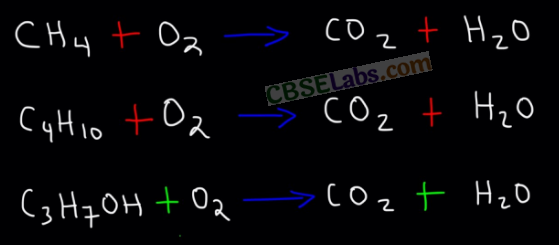
Remember:
- Saturated hydrocarbons generally give clean flame whereas unsaturated hydrocarbons give sooty flame (because carbon content is more than hydrogen content in these, and hence carbon shows incomplete combustion and appears as soot).
- Saturated hydrocarbons can give sooty flame in a limited supply of oxygen.
(b) Oxidation Reaction:
The addition of oxygen in a compound upon combustion is called oxidation.
In addition to combustion, oxidation can also be : brought about by some substances which are
capable of giving oxygen to others, i.e., Oxidising agents, e.g., Acidified K
2
Cr
2
0
7
(Potassium dichromate) and alkaline KMn0
4
(Potassium permanganate).
Note:

(c) Addition Reaction:
Addition of a molecule in unsaturated compounds in the presence of a catalyst, to give saturated compound is called an addition reaction, e.g.,
Hydrogenation of vegetable oils as shown in the reaction below :

(d) Substitution Reaction:
The reactions which involve the replacement of an atom or group of atoms from a molecule by another atom without any change in structure in the remaining part of the molecule.

13. Ethanol: (or alcohol)
Colourless liquid, soluble in water, and has a distinct smell and burning taste. Its consumption in small quantities causes drunkenness and can be lethal.
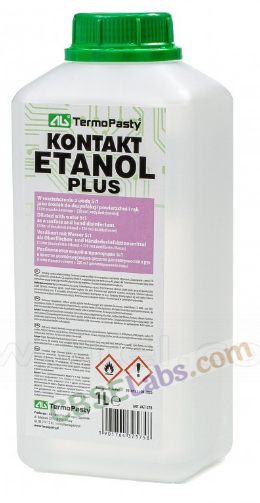
14. Ethanoic Acid: CH
3
COOH
Common Name:
Acetic Acid.
5-8% solution of acetic acid in water is called Vinegar. And 100% pure acetic acid is called Glacial acetic acid because it has m.pt. 290 K and freezes forming glacier like crystals.
Reactions of ethanoic acid :
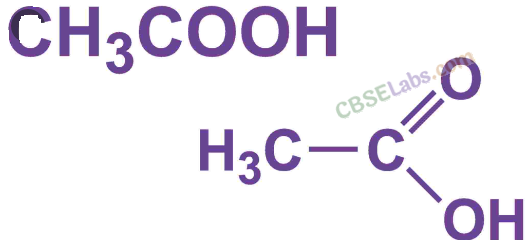
Saponification :
Esters in the presence of acid or base react to give back alcohol and carboxylic acid is called saponification.
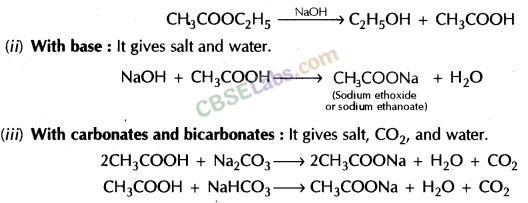
15. Soaps and Detergents :
Soaps and Synthetic Detergents: Soaps and detergents are substances used for cleaning.
Soap:
Soaps are sodium or potassium salts of higher fatty acids, such as Oleic acid (C
17
H
33
COOH), Stearic acid (C
17
H
35
COOH), Palmitic acid (C
15
H
31
COOH), etc. These acids are present in the form of their esters along with glycerol (alcohol containing three hydroxyl groups). These esters, called ‘glycerides’ are present in fats and oils of animal and vegetable origin.
Preparation of Soap: When an oil or fat (glyceride) is treated with sodium hydroxide solution, it gets converted to sodium salt of the acid (soap) and glycerol. The reaction is known as saponification.

Detergents:
Chemically, detergents are sodium salts of sulphonic acids, i.e., detergents contain a sulphonic acid group (—S0
3
H), instead^of a carboxylic acid group (—COOH), on one end of the hydrocarbon.
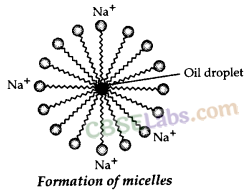
The cleansing action of detergent is considered to be more effective than a soap.
Cleansing Action of Soaps and Detergents:
The cleansing action of soaps and detergents follows the same principle.

When soap or detergent is dissolved in water, the molecules gather together as clusters, called micelles. The tails stick inwards and the heads outwards.
In cleansing, the hydrocarbon tail attaches.itself to oily dirt. When water is agitated, the oily dirt tends to lift off from the dirty surface and dissociates into fragments. This gives an opportunity to other tails to stick to oil. The solution now contains small globules of oil surrounded by detergent molecules. The negatively charged heads present in water prevent the small globules from coming together and form aggregates. Thus, the oily dirt is removed from the object.
16. Scum: The insoluble precipitates formed by soap molecule when they react with calcium and magnesium ions present in hard water. Due to this, a lot of soap gets wasted and cleansing action gets reduced to a larger extent.
NCERT Notes for Class 10 Science
- Chapter 1 Chemical Reactions and Equations Class 10 Notes
- Chapter 2 Acids Bases and Salts Class 10 Notes
- Chapter 3 Metals and Non-metals Class 10 Notes
- Chapter 4 Carbon and its Compounds Class 10 Notes
- Chapter 5 Periodic Classification of Elements Class 10 Notes
- Chapter 6 Life Processes Class 10 Notes
- Chapter 7 Control and Coordination Class 10 Notes
- Chapter 8 How do Organisms Reproduce Class 10 Notes
- Chapter 9 Heredity and Evolution Class 10 Notes
- Chapter 10 Light Reflection and Refraction Class 10 Notes
- Chapter 11 Human Eye and Colourful World Class 10 Notes
- Chapter 12 Electricity Class 10 Notes
- Chapter 13 Magnetic Effects of Electric Current Class 10 Notes
- Chapter 14 Sources of Energy Class 10 Notes
- Chapter 15 Our Environment Class 10 Notes
- Chapter 16 Management of Natural Resources Class 10 Notes